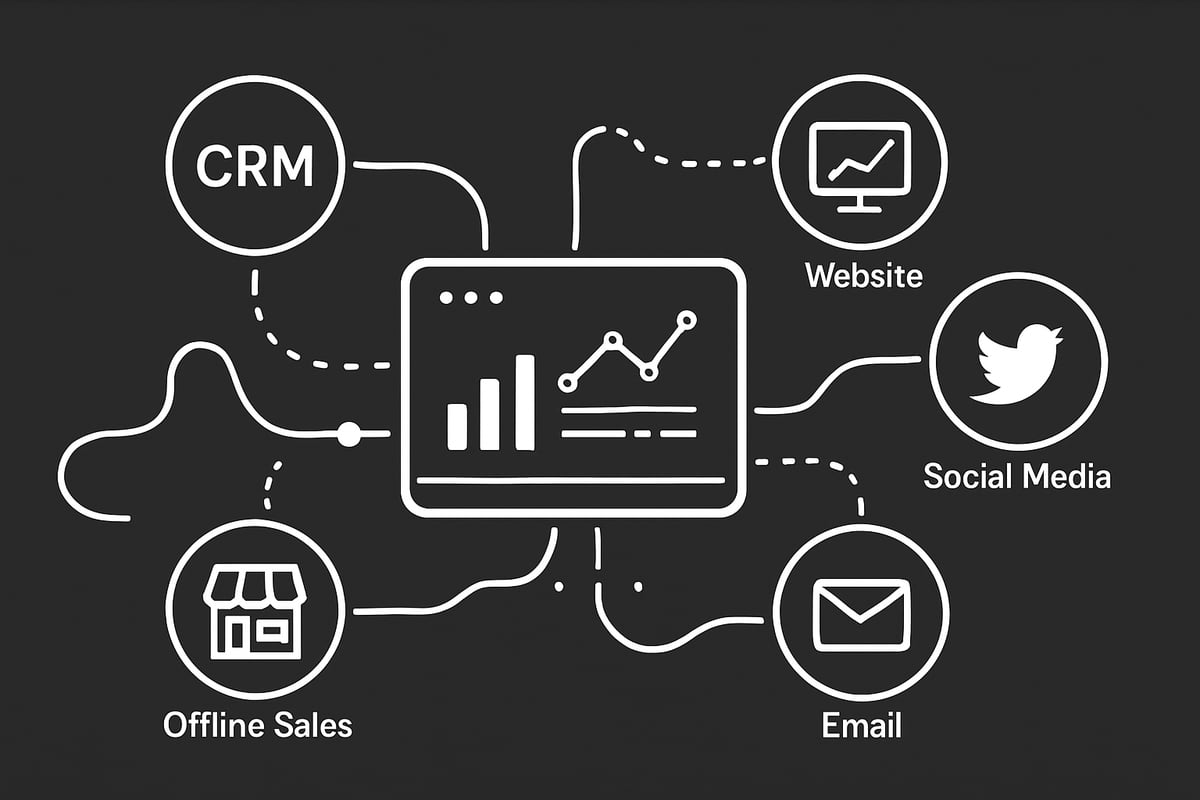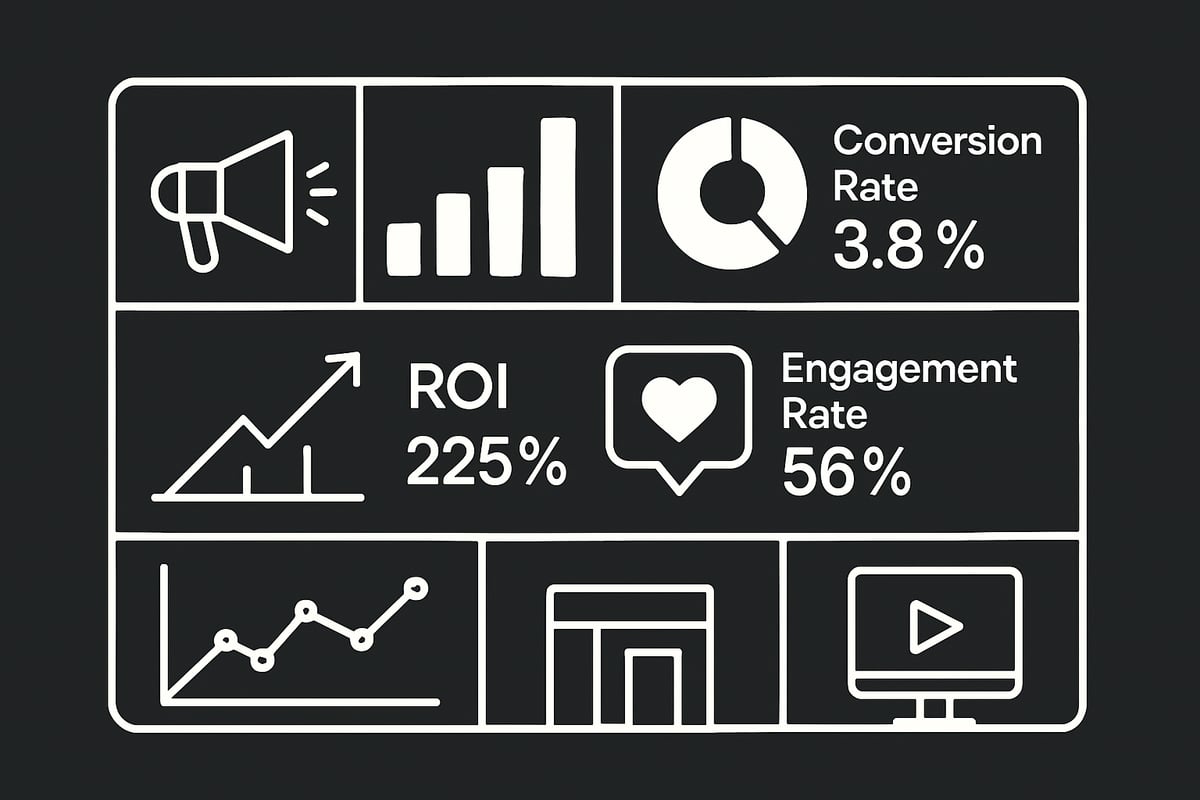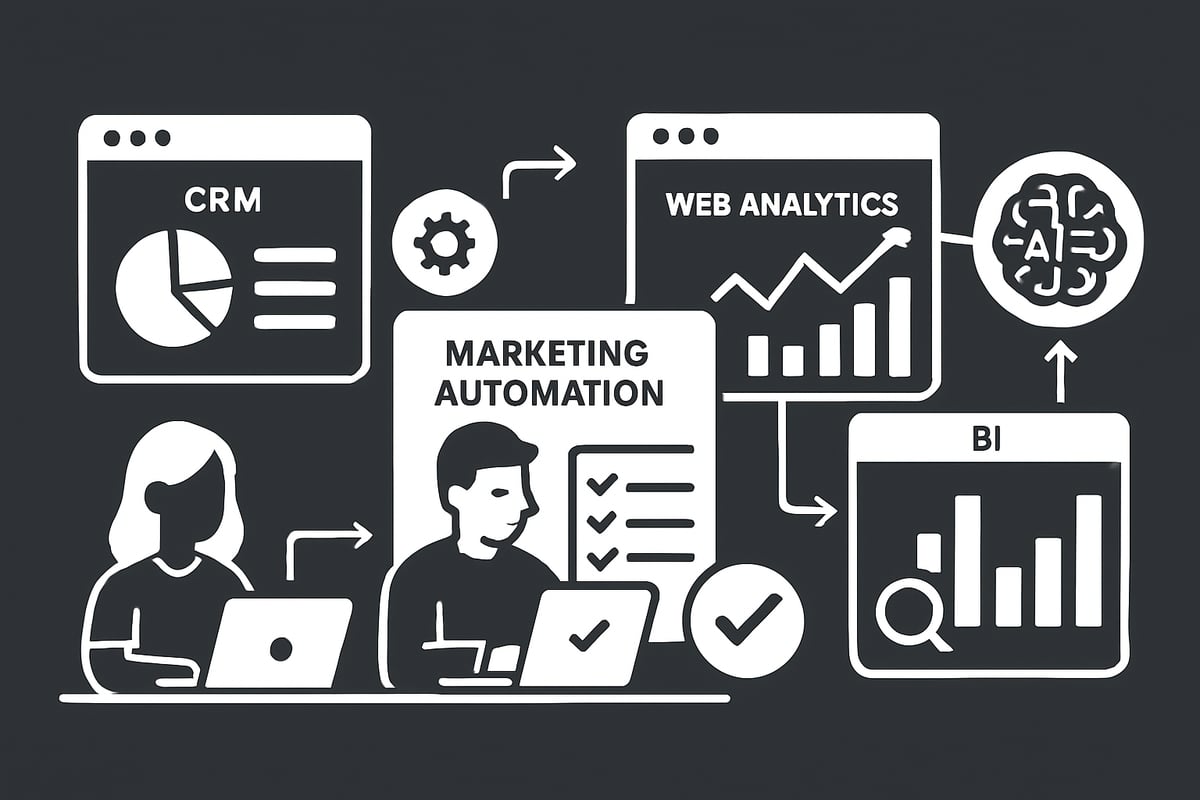In 2025, organizations face a tidal wave of customer data and soaring expectations for measurable results. Sales and marketing analytics is now the foundation for smarter business decisions and competitive advantage.
This essential guide unlocks the power of sales and marketing analytics, revealing how to turn raw data into growth, efficiency, and standout customer experiences. You'll learn what analytics really means, why it matters, and how to put it to work for your business.
Ready to bridge the gap between sales and marketing, boost ROI, and future-proof your strategy? Dive in and master analytics for the modern era.
Understanding Sales and Marketing Analytics
In today's hyper-competitive business world, sales and marketing analytics stands as the foundation for smarter, faster growth. Gone are the days of relying on gut instinct or siloed reports. Modern organizations need a comprehensive, data-driven approach to truly understand and optimize every customer interaction.

What Is Sales and Marketing Analytics?
At its core, sales and marketing analytics is the practice of systematically collecting, measuring, and analyzing data from all sales and marketing activities. This approach moves beyond static spreadsheets and isolated reports. It delivers a 360-degree view of the customer journey, capturing every touchpoint from the first ad impression to final purchase.
Unlike traditional reporting, sales and marketing analytics integrates data from multiple sources. These include CRM systems, digital advertising platforms, website analytics, social media, and even offline channels. By unifying these datasets, businesses can uncover patterns and trends invisible to siloed teams.
For example, with analytics, you can trace a lead's journey from the initial ad click, through email nurturing, to a closed deal. This enables companies to identify which channels and messages drive real results. According to Invoca, organizations leveraging analytics report up to a 5x improvement in marketing ROI.
The power of sales and marketing analytics lies in its ability to turn raw data into actionable insights. It helps leaders answer critical questions: Where do leads drop off? Which campaigns convert best? How can we optimize spend? For a deeper dive on integrating sales data with marketing analytics, see Understanding Role of Sales Data.
The Importance of Sales and Marketing Analytics
Sales and marketing analytics is essential for aligning teams and accelerating growth. It breaks down barriers between sales and marketing, fostering collaboration toward unified goals. When both teams share data and insights, they can target the right audiences, personalize messaging, and create seamless customer experiences.
Precise audience segmentation becomes possible with analytics. Businesses can identify high-value segments and tailor campaigns to their needs. Personalization increases engagement and, ultimately, conversions. Analytics also highlights areas of wasted ad spend, allowing for timely budget adjustments and improved efficiency.
A strong analytics strategy supports accurate forecasting. By analyzing historical patterns and current trends, leaders can predict demand, spot shifts in customer behavior, and plan proactively. For instance, if analytics reveals an underperforming campaign, teams can quickly reallocate resources to more effective channels.
The impact of data-driven decision-making cannot be overstated. Data-driven organizations are 23 times more likely to acquire customers. Predictive analytics further enhances this advantage by anticipating shifts in the market and evolving customer needs. With sales and marketing analytics, companies move from reactive to proactive strategies, staying ahead of the competition.
Types of Analytics: Descriptive, Predictive, and Prescriptive
Sales and marketing analytics encompasses three main types, each serving a distinct purpose.
| Type | Purpose | Example Use Case |
|---|---|---|
| Descriptive Analytics | Explains what has happened | Measuring campaign performance, web traffic |
| Predictive Analytics | Forecasts future trends | Anticipating sales pipeline, customer churn |
| Prescriptive Analytics | Recommends specific actions | AI-driven lead scoring, automated follow-ups |
Descriptive analytics answers questions about past outcomes. Predictive analytics uses historical data and statistical models to forecast future events, such as upcoming sales trends. Prescriptive analytics goes further, leveraging AI and machine learning to recommend the best next steps.
For example, a sales team might use prescriptive analytics to identify which leads are most likely to convert and trigger targeted email sequences automatically. Combining all three analytics types creates a powerful framework for holistic decision-making.
It's no surprise that 60% of top-performing companies now use predictive analytics in their sales process. Embracing the full spectrum of sales and marketing analytics equips organizations to make smarter decisions and achieve sustained growth.
Key Metrics and KPIs for 2025
In today's data-driven landscape, selecting the right metrics is crucial for maximizing the impact of sales and marketing analytics. As organizations navigate increasingly complex customer journeys, understanding which KPIs to prioritize can mean the difference between stagnant growth and industry leadership.
Sales and marketing analytics empowers businesses to focus on the metrics that drive real value. By tracking performance across marketing, sales, and digital channels, teams can align strategies, optimize spend, and deliver measurable results.

Core Marketing Metrics
Core marketing metrics are foundational for evaluating the effectiveness of campaigns and understanding customer engagement. The right set of KPIs helps marketers optimize spend, personalize outreach, and improve conversions. Here are the essential marketing metrics every organization should track in their sales and marketing analytics toolkit:
| Metric | What It Measures | Why It Matters |
|---|---|---|
| Conversion Rate | % of visitors who become leads/customers | Gauges campaign effectiveness |
| Click-Through Rate | % who click on ads/emails | Optimizes creative and messaging |
| Return on Investment | Profitability of marketing campaigns | Assesses financial efficiency |
| Marketing Qualified Leads (MQLs) | Leads likely to convert | Aligns sales and marketing efforts |
| Cost Per Lead (CPL) | Spend per lead generated | Optimizes budget allocation |
| Engagement Rate | Audience interactions across channels | Measures content resonance |
For example, an auto dealer using sales and marketing analytics might segment customers by interest, then personalize trade-in offers to boost conversion rate. Real-time analytics platforms can increase campaign ROI by up to 30%, ensuring every marketing dollar works harder.
Click-through rate (CTR) is a leading indicator of ad or email performance. Marketers use A/B testing and clear calls to action to lift CTR and drive more qualified traffic. High engagement rates signal that content resonates with the audience, while low CPL points to efficient lead generation.
Return on investment is a top priority for marketing leaders. According to Marketing Analytics Impact on ROI, businesses leveraging advanced analytics report up to 5x improvement in marketing ROI, making analytics a non-negotiable asset.
Core Sales Metrics
Sales metrics are at the heart of sales and marketing analytics, providing a clear view of pipeline health and revenue potential. Tracking these KPIs allows leaders to uncover bottlenecks, coach teams, and refine strategies for maximum impact.
Key sales metrics for 2025 include:
- Sales Conversion Rate (SCR): The percentage of leads who become customers, vital for understanding pipeline efficiency.
- Average Deal Size: Indicates revenue potential and helps prioritize high-value opportunities.
- Sales Cycle Length: Measures the time from initial contact to close; shorter cycles improve cash flow and forecasting.
- Lead Response Time: Fast responses (under five minutes) dramatically increase win rates.
- Quota Attainment & Win Rate: Track individual and team performance against targets.
- Pipeline Velocity: The speed at which deals move through the pipeline, crucial for predicting future revenue.
- Upsell/Cross-Sell Rates: Monitor additional revenue from existing customers, revealing satisfaction and loyalty.
- Sales Forecast Accuracy: Ensures reliable planning and resource allocation.
- Gross Margin: Assesses the profitability of sales efforts.
- Customer Lifetime Value (CLV): Calculates the long-term value of each customer, informing retention strategies.
A SaaS company, for example, may use win rate analysis to identify training needs and refine sales approaches. Focusing on a select group of critical metrics ensures alignment between sales and marketing analytics, keeping teams on track and driving consistent growth.
Channel-Specific Metrics
Analyzing channel-specific metrics is essential for a unified sales and marketing analytics strategy. Each digital touchpoint offers unique insights into customer behavior and campaign performance.
Key channel metrics include:
- Social Media Metrics: Followers, likes, shares, and impressions help gauge brand awareness and engagement.
- Website Analytics: Page views, session duration, and bounce/exit rates reveal user experience strengths and weaknesses.
- Email Metrics: Open and click rates indicate the effectiveness of subject lines and content targeting.
A retailer might track bounce rates to identify underperforming landing pages and use these insights to improve user experience. Channel-level data should always roll up into overall sales and marketing analytics KPIs, ensuring that reporting remains holistic and actionable.
By focusing on the right metrics across marketing, sales, and digital channels, organizations can unlock the full potential of sales and marketing analytics and stay ahead in 2025’s competitive landscape.
Tools and Technologies for Sales and Marketing Analytics
Choosing the right tools is foundational for driving results with sales and marketing analytics. With the volume and complexity of data growing each year, organizations must invest in modern, integrated solutions to ensure they extract actionable insights, streamline workflows, and maintain a competitive edge.

Essential Analytics Platforms
A robust sales and marketing analytics strategy starts with the right platforms. CRM systems like Salesforce and HubSpot centralize customer interactions and sales data, enabling detailed tracking of every touchpoint. Marketing automation tools such as Marketo or Mailchimp streamline campaign management, automate lead nurturing, and provide granular reporting.
Web analytics platforms—for example, Google Analytics—offer in-depth visibility into website traffic, conversion paths, and user behavior. Business intelligence (BI) tools like Tableau and Power BI aggregate data across sources, providing customizable dashboards for real-time decision-making. Revenue execution platforms (e.g., Invoca) bring together sales and marketing data for a unified view of performance.
Organizations increasingly seek integrated stacks to break down silos and boost efficiency. In fact, 70% of high-growth companies invest in such systems to power their sales and marketing analytics. For a deeper dive into reporting tools and KPI tracking, see Marketing Report Tools and KPIs.
Investing in the right mix of platforms ensures your analytics are comprehensive, timely, and actionable.
Emerging Technologies for 2025
The landscape of sales and marketing analytics is rapidly evolving, with next-generation technologies unlocking new opportunities. Artificial intelligence (AI) and machine learning (ML) automate data analysis, uncover predictive patterns, and recommend optimal actions. Customer data platforms (CDPs) unify information from all channels, delivering a single customer view for precise targeting.
Conversational analytics interpret voice and chat interactions, revealing insights into customer sentiment and pain points. Data integration tools ensure seamless connectivity between disparate systems, eliminating manual data wrangling.
Consider this example: an e-commerce brand leverages AI-powered analytics to identify cross-sell opportunities and personalize recommendations, directly increasing revenue. Investing in scalable, interoperable solutions is essential for future-proofing your sales and marketing analytics stack.
Organizations that embrace these technologies not only gain a holistic understanding of their market but also position themselves to adapt quickly to changing trends and customer expectations.
Data Privacy and Compliance Considerations
As sales and marketing analytics become more sophisticated, data privacy and compliance are non-negotiable. Regulations such as GDPR and CCPA demand transparent data collection, storage, and usage practices. Modern analytics tools increasingly offer built-in compliance features, including automated consent management and secure data storage.
For example, platforms now enable organizations to manage user consent seamlessly and anonymize sensitive information, reducing both risk and administrative burden. Emphasizing transparency and ethical data use fosters trust with customers and stakeholders, which is vital in today’s regulatory landscape.
Future-ready analytics strategies must prioritize compliance, ensuring that all insights are gathered and applied responsibly. By embedding privacy into every layer of your sales and marketing analytics approach, you protect your brand and build a foundation for sustainable growth.
Step-by-Step: Implementing a Sales and Marketing Analytics Strategy
Implementing a robust sales and marketing analytics strategy is essential for driving sustainable growth in today’s data-driven environment. By following a structured, step-by-step approach, organizations can unlock actionable insights, streamline processes, and maximize ROI.

1. Collect Comprehensive Data
Begin by aggregating all relevant data from sales, marketing, and customer touchpoints. Integrate information from CRM systems, web analytics, social media, and offline sources for a unified view. Prioritize data quality and completeness—address gaps, duplicates, and inconsistencies before analysis.
A well-organized data foundation is crucial for effective sales and marketing analytics. Incomplete or inaccurate data can lead to flawed insights and missed growth opportunities. According to research, 80% of analytics project failures stem from poor data quality. Proactively invest in data cleansing and validation to ensure reliable results.
2. Analyze Customer Behavior
Next, use sales and marketing analytics to understand customer journeys, trends, and pain points. Leverage descriptive analytics to review past and current performance across all channels. Identify high-exit pages, engagement drop-offs, and conversion barriers.
Tools like heatmaps and journey mapping provide visual clarity on where users disengage. Deeper behavioral analysis uncovers hidden revenue levers, helping you fine-tune campaigns and messaging. By consistently analyzing behavior, companies can adapt to evolving customer needs and preferences.
3. Segment Your Audience
Segmentation is the backbone of personalized marketing. Group customers by demographics, purchase history, engagement level, and preferred channels. With sales and marketing analytics, you can create precise segments for targeted outreach and higher relevance.
For example, identify high-value customers and prioritize them in retention campaigns. Effective segmentation increases conversion rates by up to 50%. Regularly review and refine segments to align with changing behaviors and market conditions.
- Demographic segmentation
- Behavioral segmentation
- Channel-based segmentation
Tailored strategies for each group drive better results and customer satisfaction.
4. Optimize Campaigns and Sales Processes
Optimization is an ongoing process. Use A/B testing to compare campaign elements, and attribution modeling to understand which channels drive the most value. Real-time feedback loops allow quick adjustments to messaging, creative, or budget allocation.
Sales and marketing analytics empower teams to shift resources toward high-performing tactics and cut back on ineffective ones. For instance, redirect ad spend from low-ROI channels to those delivering better outcomes. Continuous optimization ensures your strategy adapts to market shifts and competitor moves.
5. Improve Lead Generation and Nurturing
Analytics-driven lead generation maximizes both quantity and quality. Implement lead scoring based on engagement and fit, using insights from your analytics stack. Develop nurturing workflows—such as automated email sequences—triggered by specific behaviors or milestones.
Align marketing and sales on qualification criteria for seamless handoff. Sales and marketing analytics reveal which nurturing tactics yield the highest conversion rates. As a result, organizations can increase marketing-qualified lead (MQL) to customer conversion, accelerating pipeline velocity.
6. Enhance Sales Performance
Monitor sales metrics at both individual and team levels. Track key indicators like win rates, quota attainment, and lead response times. Use predictive analytics for pipeline forecasting and resource planning.
Identifying bottlenecks—such as slow follow-ups or low conversion rates—enables targeted coaching and process improvements. According to recent findings, companies using analytics for sales coaching see a 15% increase in quota attainment. For deeper insights on optimizing sales data, explore Sales Analysis for Business Growth.
7. Align Sales and Marketing Teams
Alignment between sales and marketing is critical for unified growth. Establish shared KPIs and dashboards to foster transparency and collaboration. Hold regular meetings to review analytics findings, discuss challenges, and adjust strategies together.
Workshops are effective for defining lead qualification criteria and ensuring both teams speak the same language. Sales and marketing analytics make it easier to track joint progress toward revenue goals. This alignment reduces friction, accelerates deal cycles, and delivers a seamless customer experience.
8. Measure, Refine, and Scale
Finally, set up ongoing measurement cycles. Review and refine KPIs quarterly to ensure they reflect evolving business objectives. Scale successful campaigns and sunset underperforming ones based on data-driven insights.
Use sales and marketing analytics to justify increased investment in high-ROI initiatives and support continuous improvement. Remember, analytics is not a one-time project but an iterative process. Regular review and adaptation keep your strategy agile and future-ready.
Advanced Applications & Future Trends in Sales and Marketing Analytics
As the digital landscape evolves, sales and marketing analytics are rapidly advancing, shaping how organizations compete and grow. Businesses that embrace these innovations gain a decisive edge, leveraging data for smarter decision-making, precise targeting, and sustainable revenue growth.
Predictive and Prescriptive Analytics in Action
Predictive and prescriptive analytics are transforming sales and marketing analytics from reactive to proactive disciplines. Predictive models use historical sales and marketing analytics data to forecast outcomes such as sales volume, customer churn, and campaign performance. Prescriptive analytics takes it further by recommending the best actions for sales reps and marketers, often powered by AI and machine learning.
For example, AI can suggest optimal follow-up times or product bundles based on customer behavior. According to recent forecasts, the adoption of predictive analytics in business is set to double by 2025, reflecting its growing importance in shaping future strategies. Organizations that invest in these tools can anticipate shifts and act before competitors do.
Real-Time and Integrated Analytics
Real-time analytics are now essential for organizations aiming to stay agile in a fast-paced market. Traditional static reporting is being replaced by dynamic dashboards that synthesize data from multiple sources, enabling instant insights and faster decision-making. Integrated platforms unify sales and marketing analytics, providing a single source of truth and breaking down data silos.
This shift allows teams to respond immediately to changes, such as sudden drops in conversion rates or surges in demand. Industry reports highlight that the marketing analytics market is expected to experience significant growth through 2030, fueled by the demand for real-time, actionable insights. The future belongs to those who can turn data into action quickly and cohesively.
Personalization and Customer Experience Optimization
Personalization is at the heart of modern sales and marketing analytics. By analyzing data across channels—email, web, social, and in-store—businesses can tailor experiences to individual preferences and behaviors. Dynamic content, personalized recommendations, and adaptive messaging drive deeper engagement and brand loyalty.
For instance, websites can display custom offers based on browsing history, while email campaigns adjust messaging in real time. Studies show that personalized campaigns deliver up to 8 times higher ROI compared to generic ones. As analytics capabilities advance, the focus shifts from mass marketing to creating memorable, 1:1 customer journeys that set brands apart.
The Rise of AI-Powered Market Basket Analysis in E-commerce
AI-powered market basket analysis is redefining sales and marketing analytics for e-commerce brands. By uncovering hidden product pairings in transaction data, these tools reveal high-potential cross-sell and upsell opportunities. Merchants can optimize recommendations, bundle products, and redesign category layouts to increase average order value (AOV).
Platforms like ApusNest make these advanced techniques accessible, providing easy-to-understand reports and seamless integration with popular e-commerce systems. For a deeper dive into these methods and practical strategies, explore Advanced Market Basket Analysis Strategies. As predictive and prescriptive analytics become standard, AI-driven market basket analysis will be a cornerstone for growth-focused retailers.
Data Ethics, Privacy, and Future-Proofing Analytics
With the expansion of sales and marketing analytics comes increased responsibility. Organizations must navigate complex privacy regulations such as GDPR and CCPA, ensuring transparent, ethical data collection and usage. Building trust requires clear consent processes, anonymization techniques, and ongoing compliance monitoring.
Forward-thinking businesses view data ethics as integral to their analytics strategy, not an afterthought. By prioritizing privacy and transparency, companies not only mitigate risk but also strengthen customer relationships. Future-proofing sales and marketing analytics means embedding ethical practices at every stage, ensuring long-term success in a data-driven world.